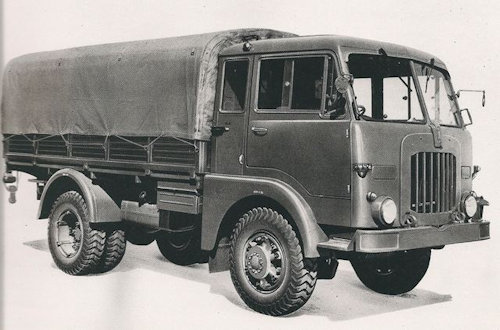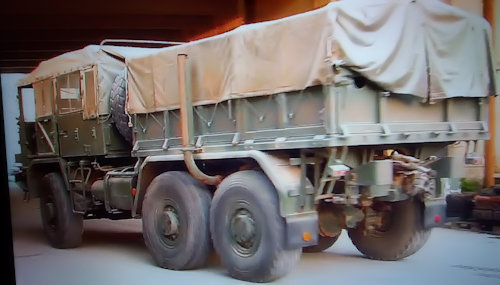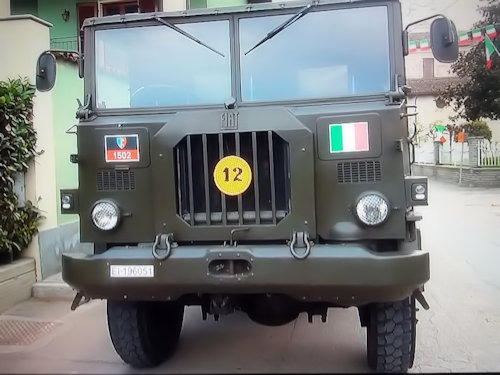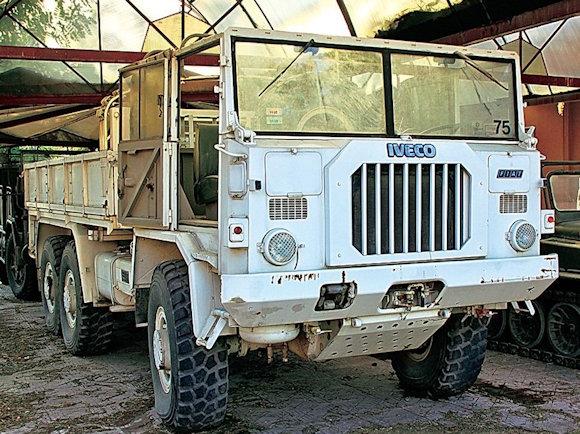Going back in time to dig into the history of some valid vehicle that has made the history of military motorization, sometimes makes you understand how much more time has passed than a birthday can. Moreover, the medium that I will propose - at least in its second "edition" -, is my age.
Massive, captivating, squared and with two round lights at the sides of a vertical air in the shape of a Greek temple, simplicity does not make it beautiful, but no one can deny its merits, among which stand out practicality and robustness. We are talking about the 62 / 70 ACP Fiat 6602 4x4 and 6x6, where the ACP initials are equivalent to the classification of "heavy-duty truck".
Alongside the work of the smallest and lightest "baffone" ACM 52 when in the barracks the ACL and ACM had not yet arrived to give it the change. He made history and filled the memories of thousands of young people and military professionals who, according to their task, interfaced every day with this means, maybe just to clean the contacts of the batteries and isolate them with Vaseline passed with a brush , or more simply for the customary controls imposed byMotor vehicle office battalion or to bring it to luster, always with a brush, but in this case with diesel.
 The ACM 52 was more associated with the concept of "military truck", perhaps for its rounded lines or perhaps for its common presence, in the versions used for public security, in the animated processions of the 70 years. The ACP, the heaviest, was considered "the real military truck", but there is also to say that most of the time it lost the A and was simply called CP.
The ACM 52 was more associated with the concept of "military truck", perhaps for its rounded lines or perhaps for its common presence, in the versions used for public security, in the animated processions of the 70 years. The ACP, the heaviest, was considered "the real military truck", but there is also to say that most of the time it lost the A and was simply called CP.
Diesel versions aspirated, but in the '62 was also petrol
The concept of a petrol truck, although it would be more correct to speak of "truck" was not really new, in fact the engines of the first half of the '900 provided, although not very widespread, eight-cycle engines - petrol - for increase the powers, since the turbo was not yet available. Some of these heavy military versions belonged mainly to the Royal Army and were characterized by the abbreviation B petrol rather than the N naphtha. In the United States, until the beginning of the 90 years, it was not difficult to come across huge Kenworth trucks or articulated lorries rather than petrol-powered Mack. After all, just remember the engine of some tank like the Lee/Grant M3 or M1 Abrams Books, but also the M113 that, as we know, derived from that of an American car.
The petrol version of the CP 62 consumed one liter per 700 meters and, despite having 90 horses and good performance, was converted by OTO Melara in the diesel version.
The numerical identification distinguished the type of engine and the characteristics of the vehicle; the 6602 was a two axis while the 6607 had three, but both as the whole series, could clearly insert the four-wheel drive and use the reduced gears and in the most difficult cases in addition to the rear differential, you could also lock the front one, a novelty this.
Its speed change did not provide, as for the XMUMX ACM, the transition to half marches and under this aspect was more coveted by the conductors. There was also the tractor version, that is a tractor used to haul heavy trailers that was classified as 52TM or medium tractor.

Single, twin tires and "cabriolet" bodywork
Depending on its use and the demands of the destination departments, its sturdy frame could lean back on twin or twin wheel pairs that had the same measurements of the covers mounted on the ACM80. Twin tires made it more suitable for heavy loads, but saliva consumption and with it also the ease of getting bogged down in the mud. The rear mechanics of the differential but also that of the engine were similar to the CM 52 with appropriate modifications and upgrades revisited to withstand the greatest efforts.
The newness
The transmission was innovative and standard with power steering and pneumatic brake. His five marches were synchronized but the shotgun was still advisable to make the changes smoother and perhaps fun; the engine brake was no longer fitted with a lever on the dashboard but with a pneumatic pedal placed near the clutch and which blocked part of the exhaust manifold.
But perhaps the most innovative aspect is a certain colonial and Saharan reference, dictated by the rear opening of the cabin that saw the use of a roll-up tarpaulin with the same system as the Citroen 2 horses.
The windshield frame was not constrained by the structure but fixed on hinges and could be removed or lowered, as well as the doors that opened upwind and could also be locked open on the side. These were the characteristics that remained perhaps more impressed after seeing for the first time the CP in the barracks. However, the three-axis versions, common in Genius and Alpini, could have a double cabin, but in this case it was all made of sheet metal.
CM 52 and Lancia ACL, in between the 70 CP
 The bulk of the logistical and operational work was undoubtedly carried out by the ACM 52 which was the most widespread, but to lighten the tasks of the two trucks, the first "futuristic" series came to the rescue in the 75 for the era of ACL marked Lancia.
The bulk of the logistical and operational work was undoubtedly carried out by the ACM 52 which was the most widespread, but to lighten the tasks of the two trucks, the first "futuristic" series came to the rescue in the 75 for the era of ACL marked Lancia.
The heavy truck CP when it was not the joker between these two cars had to do with the vehicles of the series Astra BM 200, more comfortable and civil derivation and used in the tipper or trailer versions of artillery tanks, the "cold" prerogative of these means, including CP, he tested the driver's ability. It was a bit like the characteristic of the drum brakes that, if the stopping distances stretched with the wet, in winter they made the first braking traumatic. Generally, the conductor, before starting the service, threw the CP into the maneuvering yard and then made two or three nailed to heat the drums that, once they reached the proper temperature, were very efficient.
The most salient features
Drive strictly to the right, at least until the 70 version, when it was moved to the left and, thanks to the huge availability of spare parts, this truck continued to perform its service until the end of the 80 years.
The diesel version had a displacement of 9816 cc for just under 200 horses and a speed higher than 80 km / h, the flow rate was five tons compared to its weight of seven and a half tons. The height of 3 meters, in addition to being appreciated in traffic and by the drivers, allowed him to plunge into fords up to one and a half meters. A real mule for what concerns the tow that could go up to 10 tons. An innovative ratchet system was also available Hill Holder to avoid the upward slope when loaded. On the dashboard in addition to the few Spartan spies at 24volt and the entrance to the "nail" was the hand throttle lever, also used to give more power to the PTO.
 Real drivers vs licensed
Real drivers vs licensed
This difference has already been discussed and we know that it is also underlined in the forums of fellow drivers. In fact, it can not be denied that there is a huge difference between those who after obtaining their driving license with a few hours of driving are convinced - with a "pinch" of presumption - to be a complete driver and those who are on the wheel of a heavy vehicle and on the roads every day. Being a driver is also a philosophy of life that is understood only by doing this job, but above all it is a commitment that requires malice and experience, two skills that are refined throughout the working life.
However, the era of gods touch screen and joystick he represented for the youngest a physiological and drastic loss of manual mechanical competence; it should be remembered that, although the "CP" was more modern than the 52 ACM, the military driving school continued to use the most complex "CM 52 baffone" until the 80 years.
A good and useful "gym" for the military to train conductors, many of whom, thanks to the military service, have undertaken this profession, which today unfortunately seems to be undermined by economic globalization and by now insignificant earnings; in this regard, the same trade associations are launching sound even if unheard alarm signals.
The story of a friend, a lieutenant
Friend is now, but at the time was my direct superior of which I also remember some sound "cazziatone" that had lifted me from the ground rigid and attention. The assistant marshal Filippo Formica, of the 3 ° btg trs Spluga, today 1 ° rgt broadcasts, he wanted to tell me an episode of his career right on board the 70 ACP. It must be said that in addition to his great preparation in the field of transmissions was and still is a human person with a great sense of humor, so as to defuse any event.
 When he was a senior sergeant, he and his team had been ordered to reach a remote village in the high mountains on board an ACP where, as he explained, there was a sort of "electromagnetic visibility" ideal for installing AN valve radio systems. Rmc 69 placed inside the Shelter transported to the loading floor of the Fiat 6602 CP. Satellite systems were not yet refined and communications traveled with "repeat bridges" to the nodal center.
When he was a senior sergeant, he and his team had been ordered to reach a remote village in the high mountains on board an ACP where, as he explained, there was a sort of "electromagnetic visibility" ideal for installing AN valve radio systems. Rmc 69 placed inside the Shelter transported to the loading floor of the Fiat 6602 CP. Satellite systems were not yet refined and communications traveled with "repeat bridges" to the nodal center.
During the mission, after an abundant flood lasted two days, his ACP remained mired and stuck in the ground turned into a swamp. It was only thanks to a winch from 9 tons of pull present at the front and rear and to the insertion of the power take-off that managed to come out of an experience certainly not easy. However, Filippo Formica remains of the opinion that the CP was one of the best and successful vehicles supplied to the Armed Forces.
A nice fellow soldier
Originally from a locality on the border between Lazio and Campania, Pica's surname was a boy who, before the military, worked as a driver having obtained the license just completed the 21 years and being able to postpone the service of a few years.
I, a few years younger, I always tried to support him as a machine boss and he, during the maneuvers near the warehouses in the barracks, he taught me many details of the CP. In civilian life she carried caravans with a car transporter and after the soaps in the corridor of the spans in t-shirt, boxer shorts and slippers, she enjoyed simulating with her mouth the air vent of the truck when stationed and even the noise of the changes. Really unique and unique this boy of whom I have unfortunately lost contact. This was the military lever, many experiences that perhaps formed the men of the future with more humility.
A second life. The high quality and reliability allowed the 70 CPs to be converted, once dismantled by the Armed Forces, into public utility vehicles, such as snow plows, towing cranes, and so on. Many ended up in Africa and others were transformed into 4x4 campers, like the ACMs.
I conclude by saying goodbye to all the Alpini and the departments of the genius who have made thousands of kilometers in the thirty years of life of the 62 / 70 ACP.












